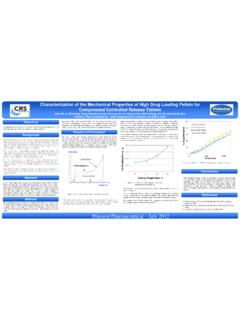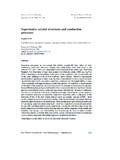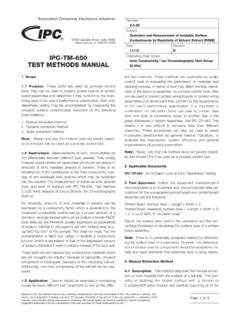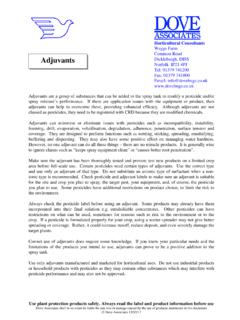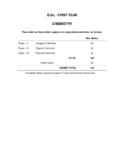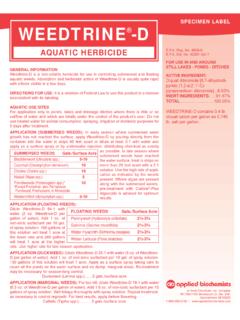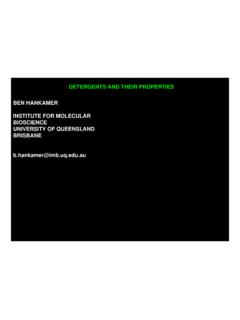Transcription of Ionic Interaction to Achieve 24 Hour Zero Order …
1 Ionic Interaction to Achieve 24 Hour Zero Order Release for a Freely Soluble Drug F. Cai, S. Yang, J. Cai, K. Zhang, H. Chen, R. Luo, M. Wang, X. Guo Prinston Pharmaceutical Inc., 2002 Eastpark Blvd, Cranbury, New Jersey 08512, USA Materials Objectives Background Methods Conclusions References AS, et al. J. Pharm. Sci., 93(2004):2319-31 S, Farmaco, 58(2003):1051-1056 S, et al. Eur. J. Pharm. Biopharm., 52(2001):75-82. SA, Drug Dev. Ind. Pharm., 27(2001):925-34. The extended-release (ER) products of highly water soluble drugs are commonly formulated as osmotic pump, bilayer/trilayer tablets, multi-pulse microparticles, matrix tablet with functional coating or matrix tablets using gastric retention technology.
2 It is difficult to Achieve up to 24 hour release for matrix tablets composed of common release controlling non- Ionic polymers. Recently, the approach of Ionic interaction1-4 between basic drugs and anionic polymers along with a blend of non- Ionic polymers achieved extended release. H131, a very high water soluble basic model drug with a low dose, was designed to be once-a-day matrix tablets with up to 24 hour drug release (>90% at 24 hour) with a good linear release (R2> ) by its Ionic Interaction with anionic polymers, such as Eudragit L100-55 & Carbopol 971P.
3 A 24 hour zero Order release tablet containing a freely soluble basic drug (H131) the effect of anionic polymers and hydroxypropyl methylcellulose (HPMC) on drug release rate the different manufacturing processes on drug dissolution profile Neutral polymer and/or wax alone failed to control H131 release for up to 24 hours from matrix tablets due to API s high water solubility and low dose. Anionic polymers, such as Eudragit L100-55 and Carbopol 971P, could interact with H131 at neutral and high pH environments. The combination of anionic polymers and HPMC can retard H131 release from matrix tablets.
4 The approach applied drug-anionic polymer Interaction to prolong drug release up to 24 hours with near zero Order release was successfully demonstrated. The manufacturing processes have a significant effect on drug release. Results and Discussion H131 (Zhejiang, China), Hydroxypropyl methylcellulose - Methocel K100 LV, K4M, K15M, K100M (The Dow Chemical Company), Lactose Monohydrate (DMV-Fonterra), Glyceryl Behenate - Compritol 888 ATO (Gattefosse), Colloidal silicon dioxide - Aerosil 200 Pharma (Evonik), Methacrylic Acid Copolymer, Type C - Eudragit L 100-55 and Eudragit L 30 D-55 (Evonik), Carbomer Homopolymer Type A - Carbopol 971P NF (Lubrizol), Magnesium stearate (Mallinckrodt).
5 BLENDING Blend the above granules with HPMC, filler and colloidal silicon dioxide for 10 min, then add magnesium stearate and blend for another 3 min. For direct compression, mix the weighed materials, except for magnesium stearate, for 5 min, pass through a 20 mesh screen and then blend for 10 min. Add magnesium stearate, passed through a 30 mesh screen, and blend for 3 min. COMPRESSION The above blends were compressed into round tablets with weight around 350mg and hardness approximately 8Kp. DISSOLUTION TEST The release of H131 from matrix tablets was analyzed by a HPLC method with UV detector using USP apparatus I at 100rpm in pH phosphate buffer.
6 H131 is a freely soluble, weak basic drug. Interestingly, HPMC alone or HPMC/wax blend cannot effectively control the drug release up to 24 hours with as high as 80% Methocel K100M in the matrix tablet, and only first Order release profile was observed. When the drug formulated with anionic polymer Eudragit L100-55 and Methocel K100M, the drug release can be controlled up to 24 hours (Fig. 1). GRANULATION Wet granulation H131 mixed with filler and anionic polymers, such as Eudragit L 100-55 or Carbopol 971P. Add water, Eudragit L 30 D-55 or isopropyl alcohol to conduct wet granulations.
7 Hot melt granulation - H131 mixed with filler and Compritol 888 ATO. Heat the mixture to about 70oC under mixing and get granulation after the mixture cool down to room temperature. Dry granulation H131 mixed with filler, anionic polymers, such as Eudragit L 100-55, and magnesium stearate. Dry granulation was obtained from a roller compactor. All the granulations were passed through a 20 mesh screen Fig. 1: Dissolution of H131 ER Tablets containing various polymers. Fig. 2: Effect of HPMC on release of H131 ER tablets containing Eudragit L100-55.
8 HPMC (30%) grades don t show a significant effect on dissolution of the formulations containing 23%w/w Eudragit L100-55 once their viscosity grades reach Methocel K4M or higher (Fig. 2) H131 ER tablets were manufactured by three different methods, wet granulation, dry granulation and direct compression. The manufacturing processes have a significant effect on drug release profiles. The dissolution results indicate that wet granulation has the slowest release profile, and direct compression shows the quickest drug release rate (Fig. 4). Drug release decreased with the increase of Eudragit L100-55 from 23%w/w to 46%w/w for H131 ER tablets containing 30% Methocel K15M or blends of 15% Methocel K100LV and 15% Methocel K15M.
9 The HPMC blends give a better linearity than Methocel K15M alone, especially, for the formulation containing a high amount of Eudragit L100-55 (Fig. 3 and Table 1). Fig. 3: Effect of Eudragit L100-55 on the dissolution of H131 ER tablets. Fig. 4: Dissolution of H131 ER tablets made by different granulation methods. Carbopol 971P NF is another anionic polymeric excipient that is often used in extended release formulations. It has the synergistic effect when it is formulated together with HPMC. The dissolution profiles become slower when more Carbopol 971P is used in the formulations (Fig 5).
10 Fig. 5. Dissolution of H131 ER tablets containing different amount of Carbopol 971P. Fig. 6: Dissolution of H131 ER tablets containing Carbopol 971P and HPMC. H131 ER formulations containing HPMC blend of 15% Methocel K15M and 15% Methocel K100LV showed better linearity. The R2 is higher than for H131 ER tablets composed of 30% HPMC blend and 20% or 30% Carbopol 971P (Fig. 6 and Table 1). Anionic Polymers Formulations R2 Eudragit L100-55 Formulations (Fig. 3) 23%Eudragit L100-55/30%Methocel K15M 23%Eudragit L 100-55/30% HPMC Blend 35%Eudragit L 100-55/30% HPMC Blend 46%Eudragit L 100-55/30% HPMC Blend Carbopol 971P Formulations (Fig.)
